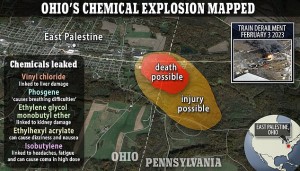From the Staff Report, Chemical Engineering Progress, April 10, 2023
In the wake of the Norfolk Southern train derailment that released hazardous chemicals into the environment in East Palestine, OH, citizens are seeking out independent testing to determine what kind of contamination the town may be facing.
Both individuals and university teams have been conducting their own sampling of the area near the chemical release. These results are still being analyzed, but initial reports suggest that there are chemicals in streams and wells in East Palestine that state and federal agencies are not looking for.
“One of the biggest issues with this response has been transparency,” says Andrew Whelton, a professor of civil and environmental engineering at Purdue Univ. who is leading some of the independent testing. “As things have become more visible, we’ve found out that officials haven’t been testing for the right chemicals.”
For instance, governmental officials had not conducted indoor surface testing of homes near the spill site as of early March. A contractor for Norfolk Southern did one-time air monitoring in some homes, but residents told reporters that they were not informed that the testers were hired by the rail operator, according to The Guardian. Experts also say that these one-time, short-term air sampling tests are not sufficient to show that indoor air is safe. The tests conducted can detect certain volatile organic compounds, but do not measure other potential pollutants from the spill, such as benzene.
Experts have also raised concerns about dioxins, which are carcinogenic and highly persistent in the environment. The U.S. Environmental Protection Agency (EPA) is requiring Norfolk Southern to test for dioxins within two miles of the spill site, although details of the testing plan are unclear.
The derailment occurred on Feb. 3, 2023, when dozens of freight train cars carrying hazardous materials, including vinyl chloride, isobutylene, and butyl acrylate went off the tracks and caught fire near the Ohio-Pennsylvania border. Several days later, officials made the decision to flare off the vinyl chloride for fear of an explosion should the flammable chemical ignite. Residents complained of chemical smells, rashes, and headaches in the days following the crash and the controlled release.
A lack of interagency communication and communication with the public created a sense of mistrust among residents from the early days after the accident. The state and county environmental and health agencies did not immediately release their testing data, nor were they forthcoming about what chemicals they were testing for, Whelton says. As a result, residents who could afford it began to seek testing through independent laboratories, and volunteers from around the country have started working to build tools to help coordinate the sharing of the results.
Devon Oship, a neuroscientist in Buffalo, NY who has a platform on TikTok, began creating forms for residents to report health symptoms, an effort that has grown into a database for citizens to report their own independent testing data under a nascent organization called United for East Palestine.
“We have been racing against the clock to make a database that can keep up with all of the new influx of information and has a good data structure to allow for a really robust analysis,” Oship says. The goal is to compare the citizen-science results with official testing results from the state and federal EPA, county health department, and other responding agencies.
Independent results are still rolling in, Oship says. Whelton and other researchers at Purdue Univ., Carnegie Mellon, and Texas A&M have also traveled to East Palestine to take air and water samples and screen them broadly. So far, Whelton and his team have found that two creeks near the derailment site, Sulfur Run and Lesley Run, are contaminated with acrolein, butyl acrylate, 1,2-butadiene, ethylene glycol, naphthalene, butyl acrylate, n-butyl ether, 2-butoxy ethanol, and 2-ethyl hexanol.
Upon the team’s first visit in late February, only data about surface water in the creeks had been released, showing low contamination, Whelton says. But locals weren’t warned about possible contamination in the streambeds.
“We found that people were walking their dogs near the creek and the kids were playing near the creek because they were not told about the acute, immediate health risks the creeks posed to them,” Whelton says.
The testing revealed gaps in the official surveillance. For example, the federal EPA had found acrolein in the air after the chemical release but had not tested surface water or drinking water wells for the chemical, Whelton says. He and his team are now doing further analysis to determine whether the levels of these contaminants are dangerous.
Whelton has conducted environmental testing in the wake of other disasters, including the 2022 Marshall Fire in Colorado, and says that communities and local agencies differ in their support of bringing in outside experts and providing transparency. The situation in East Palestine has been “markedly different” than the norm, he says, with agencies being slow to publicize what chemicals they were testing for and where.
The usefulness of business and property owners testing their own soil, water, and air will likely depend on what testing is available from whichever commercial lab they choose, Whelton says. Comprehensive environmental monitoring is financially out of reach for most, he says. Even Whelton and his team are unsure if they will be able to afford to return to East Palestine for additional sampling, given that they are self-funding the effort. But citizens can continue to pressure politicians and environmental agencies to expand the testing agenda, he says.
“The only way [residents] can really support the response is by requiring and demanding that the officials that are supposed to be acting in their best interest do so,” Whelton says.

